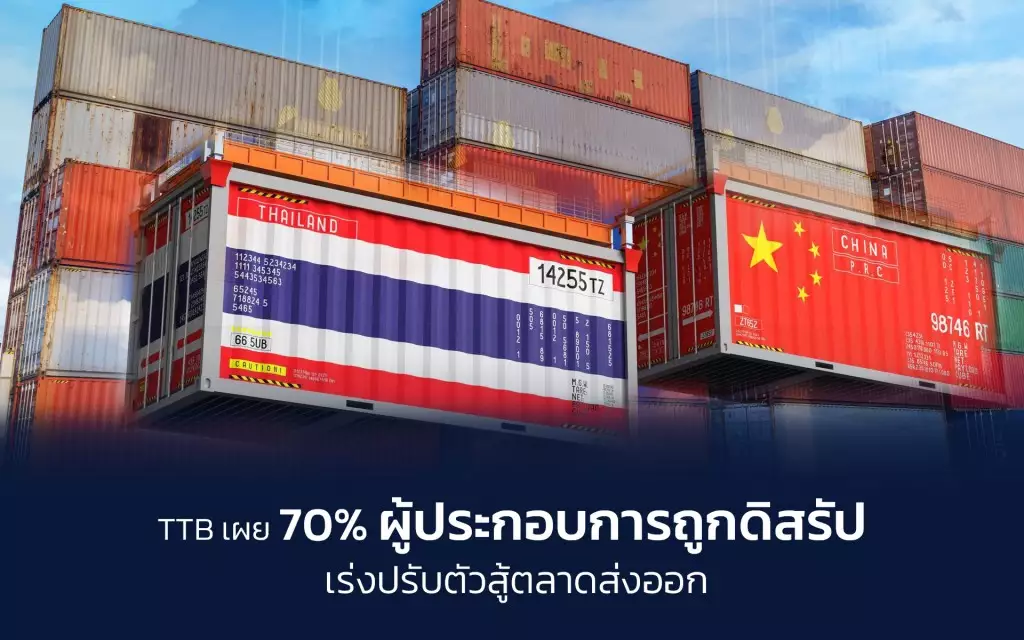Bangkok Terminal Logistics Co., Ltd.

TTB reveals 70% of entrepreneurs are disrupted, rushing to adapt to compete in the export market
Thai exports are facing significant challenges in a climate of increasingly competitive trade, particularly as most industries are severely disrupted.
TTB Analytics stated that 70% of Thai entrepreneurs face disruption and challenges from competition in the global market, forcing entrepreneurs to quickly adapt to cope with changes in the import and export industry, especially in groups that rely heavily on imports from China.
Overview of Thai exports and disruption
TTB Economic Analysis Center has pointed out that the global market competition of Thai exports has begun to decline when considering long-term data, in the past 30 years.
The market share of Thai exports in the world market has not increased significantly compared to competing countries that have been able to continuously develop their quality and production to have higher competitive potential.
Thailand’s main export products, such as agricultural products and processed foods, are still in demand in the world market. However, relying on traditional markets such as the United States and China has increased the competitive risk. In addition, competitors from other countries have started to compete for market share from Thailand, especially in the group of products with low added value.
In addition, industries that rely on imports from China, such as electronics, electrical appliances, and chemicals, are facing the risk of intense competition from competitors such as Vietnam and Malaysia, which have been able to develop their industries quickly.
This has caused Thailand’s market share in this product group to continuously decline. For example, refrigerator exports, which used to have a market share of 4.7% in 2013, have now declined to only 3.3%.
Impact of international trade agreements
In addition to competition in the global market, another important factor that causes Thai entrepreneurs to face additional challenges is the international trade measures that have become almost six times more stringent in the past 10 years, whether they are tax measures or non-tax measures, such as the European Union Deforestation Regulation (EUDR) and the Carbon Border Adjustment (CBAM).
This leaves Thai entrepreneurs facing increased costs and restrictions when trading with these countries. Moreover, Thailand remains at a disadvantage in terms of customs tariffs compared to its major competitors, Vietnam and Malaysia. Thailand’s average customs tariffs remain higher than those of its competitors, which impacts Thailand’s competitiveness in the international trade arena.
Guidelines for Thai entrepreneurs to adapt
According to TTB Analytics, Thai entrepreneurs need to quickly adapt to survive and compete in the long term, especially in high-risk industries. Entrepreneurs need to develop products and trading strategies to respond to rapid changes in the global market.
TTB Economic Analysis Center has divided entrepreneurs into 4 groups based on the level of risk in relying on foreign markets and importing goods from China. The highest risk group is the group that relies heavily on exports and imports, which has a proportion of Thai entrepreneurs at 16% of the total.
This group is extremely vulnerable as most of them are OEMs that rely on raw materials from China to produce and export to third countries. If they cannot develop value-added products or expand their markets, entrepreneurs in this group will face a greater risk of losing market share.
Another group that is also at high risk is the group that relies heavily on imports from China but has low exports, which accounts for 12% of all Thai entrepreneurs.
This group is an industry that imports products from China to support the domestic market, such as the steel and machinery industries. The increase in imports of products from China for production and sale in Thailand has caused domestic entrepreneurs to face fierce competition from Chinese manufacturers.
The medium-risk group, which accounts for 40% of all operators, is the group that has a moderate reliance on exports and imports from China, such as the chemical, packaging, automotive and parts industries.
This group is starting to see rapid growth in imports from China. If they are unable to expand their domestic and international markets further, the industries in this group may face the impact of intense competition in the future.
Meanwhile, the low-risk group, which accounts for 32% of all Thai entrepreneurs, is the group that relies on exports and imports from China to a low level. This group is the least risky.
Since they mainly use domestic raw materials to support domestic demand, industries in this group, such as food and tourism, are expected to be less affected by changes in international trade than other industries.
Conclusion
Thai exports are facing major challenges from changes in the global market and disruption from increased competition. Entrepreneurs need to quickly adapt to these changes by developing value-added products, expanding into new markets, and reducing dependence on imports from China. If Thai entrepreneurs can adapt in time and have good management, their chances of surviving and competing in the global market will increase.
Data source: Thai PBS